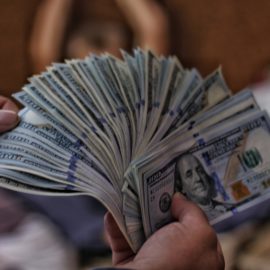

This article is an excerpt from the Shortform book guide to "Liar's Poker" by Michael Lewis. Shortform has the world's best summaries and analyses of books you should be reading.
Like this article? Sign up for a free trial here.
What are Collateralized Mortgage Obligations (CMOs)? How did CMOs defuse the mortgage bond market?
During the height of the mortgage bond market, Lewis Ranieri started convincing banks to trade their bonds more frequently, allowing himself and Salomon Brothers to skim profits off every transaction. That was until CMOs came along.
Discover more about the fall of the mortgage bond market.
Mortgage Bonds Decline
Despite Salomon Brothers’ roaring success with the mortgage bond market in the first half of the ’80s, no gravy train runs forever. Beginning in 1986, Salomon’s Wall Street dominance declined as Collateralized Mortgage Obligations were introduced. In Liar’s Poker, Michael Lewis recounts three separate ways that Salomon Brothers eroded their standing in the mortgage bond market—they allowed other banks to snatch away their best traders, they developed a new financial product that undercut the value of traditional mortgage bonds, and the leaders of Salomon’s mortgage bond department indulged in so much personal excess that Salomon’s executives had to take a stand against them.
As Lewis stated earlier, Salomon Brothers recruited many new traders from the legions of economics students in the 1980s, none of whom had any loyalty to the business. More than that, Salomon restricted their pay for the first two years of employment, regardless of how much money they brought in. This allowed other Wall Street banks to lure them away with higher salaries and bonuses. For young traders, Salomon simply became the place where they went to receive on-the-job training before sailing off to more lucrative positions. Not only did this drain Salomon’s talent, but it also gave away the firm’s advantage by transferring its trading strategies and techniques—along with its monopoly in the bond market—into the hands of its rivals.
(Shortform note: To this day, Wall Street investment bankers are compensated with a combination of salaries, commissions, and bonuses. In general, an investment firm will return half its net annual earnings to its executives and traders, divvied up on the basis of individual performance and the returns of a firm’s various divisions, such as government bonds or mortgage-backed securities. In Lewis’s time on Wall Street, salaries and bonuses were often common knowledge and points of competition between traders, but in 2017, New York City passed a law prohibiting investment firms from learning how much potential employees were paid when working for rival banks.)
Lewis writes that besides the steady loss of talent at Salomon, new financial products called Collateralized Mortgage Obligations (CMOs) defused the mortgage bond market by removing the bonds’ volatility that had made them ripe for speculation. Salomon had actually devised these tools themselves to make mortgage bonds attractive to traditional investors. A CMO divided a bundle of mortgages into three or more “tranches” that matured at different rates. Money from homeowners who paid their loans early would go to the holders of tranche #1 until their investment was paid back in full, before rolling payments to tranches #2 and #3. Therefore, tranche #1 was a short-term investment, and tranche #3 was long-term.
Lewis explains that by bringing predictability to mortgage bond payouts, CMOs attracted new investors such as pension funds who wouldn’t have touched unpredictable mortgage bonds in the past. CMOs made mortgage bonds as respectable as corporate and government bonds, but they also normalized the value of those bonds. Because of CMOs, investors now had a better understanding of what mortgage bonds were worth, making it harder for Salomon Brothers’ bond traders to bamboozle their clients as they had in the past. To stay on top of the market, Salomon’s traders kept inventing even more complex and mystifying products that they could hawk to buyers as their next “get rich quick” scheme.
| The Next Wave: Collateralized Debt Obligations The next iteration of asset-backed securities wasn’t created by Salomon Brothers but by its rival firm Drexel Burnham, which we’ll discuss in the next section of this guide. The financial product in question is the Collateralized Debt Obligation (CDO) which collects and restructures high-risk corporate bonds in the same way that CMOs restructure mortgage bonds. First introduced in 1987, CDOs became a tool for bundling subprime mortgages, replacing CMOs during the housing boom that started when interest rates dropped in 2002. Because of how the loans were repackaged, these CDOs were given AAA ratings—a mark of low risk and high creditworthiness—by leading credit agencies like Standard & Poor’s (S&P), disguising the inherent risk of the loans. When subprime borrowers began defaulting on their loans in 2007, the CDOs based on their mortgages translated those defaults into 2008’s global financial crisis. Because CDOs aren’t traded on public exchanges, the hedge funds, banks, and pension funds that had heavily invested in them were stuck holding the bag. In The Big Short, Lewis’s book about the subprime crisis, he explains how banks and investors who couldn’t offload their toxic CDOs saw their assets disappear overnight. Despite the lessons learned from the crisis, the grandchildren of Ranieri’s mortgage-backed securities—now called Collateralized Loan Obligations (CLOs)—have made a comeback in the 2020s, leading analysts to worry about another future bubble and collapse. |
Lewis Ranieri Exits Salomon Brothers
Despite their efforts, Salomon’s mortgage bond profits steadily dropped from 1986 to 1987. Lewis writes that because of this, Salomon’s board took a harder, closer look at the behavior of Ranieri’s bond traders. A faction within Salomon’s upper management had a growing distaste for the drunken schoolboy antics of Ranieri’s inner circle and would no longer ignore the way Ranieri and his friends misused company resources. In July 1987, Gutfreund fired Ranieri for reasons that have never been specifically disclosed, and Ranieri’s closest colleagues were also let go over the next several months.
Even with Ranieri gone, his legacy remained. Lewis asserts that because of Ranieri, mortgage bonds had risen from obscurity to become a major source of business on Wall Street. Because of the way Ranieri’s mortgage department had reshaped the culture of Salomon Brothers, and because the firm had let its talent slip away to every other major bank on Wall Street, the cutthroat tactics and backhanded dealings that epitomized Salomon Brothers’ trading floor were now the norm for investment banking in general. Salomon Brothers’ Wall Street dominance continued in spirit, if not in financial fact.
| The Good, the Bad, and the Wealthy Though Lewis writes from a Salomon-centered point of view, the financial profession’s hedonistic behavior and shady dealings aren’t limited to Salomon Brothers alumni. Jordan Belfort’s memoir The Wolf of Wall Street—the basis of the 2013 film—depicts lavish parties, drug use, and outright financial fraud far in excess of anything related by Lewis at Salomon Brothers. In Billion Dollar Whale, Tom Wright and Bradley Hope detail the even more outlandish wrongdoings of Malaysian financier Jho Low, who employed fraud on a global stage to fund parties, gambling binges, and his glamorous lifestyle. However, it wouldn’t be fair to suggest that everyone in the financial business is characterized by bad behavior. John C. Bogle, founder of the Vanguard Group and author of The Little Book of Common Sense Investing, was praised for his integrity, financial restraint, and support of the common investor. Ruth Porat, former CFO of the investment bank Morgan Stanley before becoming CFO at Google, is known for opening doors for women on Wall Street, fighting against workplace sexual harassment, and helping struggling small businesses in the aftermath of the Covid pandemic. Warren Buffett, arguably the most successful investor in history, is known for bucking every negative Wall Street stereotype. In The Snowball, his biographer Alice Schroeder writes that Buffett’s humble beginnings led to a humble life, one that was defined by his sense of integrity even after he became the world’s richest man. That integrity would come to Salomon Brothers’ rescue, as we’ll see later in this guide. |

———End of Preview———
Like what you just read? Read the rest of the world's best book summary and analysis of Michael Lewis's "Liar's Poker" at Shortform.
Here's what you'll find in our full Liar's Poker summary:
- A first-hand account of the pursuit of ill-gotten riches at the Salomon Brothers
- The boom and burst of the mortgage bond market
- Where there is room for ethics and level-headed investing






